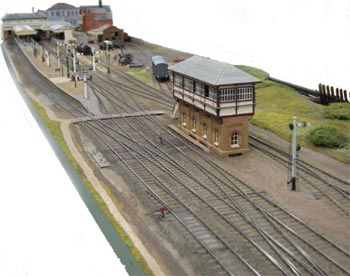Laying the Track
Detailed 'how to build it' guides are available from each manufacturer along with all the components. One of the advantages of P4 is that all the components are very close to scale, and thus it is possible to build any formation of points and crossings used on the prototype. Whatever construction system is used, the assembly will be built with the aid of a drawing, usually called a 'template'. This allows the formation to be built on the workbench in good lighting and to be transferred to its final location on the layout once complete. Templates are available for most common track formations from the component suppliers. They can be also be created and printed at home, using a computer program such as 'Templot', which allows you to design your track formation on the computer and then print out templates for each element as required.
Once built, the track and points need to be laid. Underlay to represent the trackbed is available in convenient ready-cut strips of cork sheet or in closed cell foam. Alternatively the modeller can purchase larger sheets and cut to the size required. The track should be glued to the underlay using a diluted PVA glue or similar; ballast may be added at the same time or can be added later if preferred.
 A variety of gauges and
aids is available to help you ensure accuracy without needing to worry
about the actual measurements. Photo: Jim Summers
A variety of gauges and
aids is available to help you ensure accuracy without needing to worry
about the actual measurements. Photo: Jim Summers
Additional detailing
 Having
built, laid, ballasted and weathered your track you may wish to
consider additional detailing to enhance its realism. Components are
available from a number of manufacturers, covering such items as dummy
point rodding and operating cranks, signal pulley wheels, facing point
locks, third and fourth rail, and so on. The photo on the right shows
the two varieties of conductor rail supports for third and fourth rail
prototypes.
Having
built, laid, ballasted and weathered your track you may wish to
consider additional detailing to enhance its realism. Components are
available from a number of manufacturers, covering such items as dummy
point rodding and operating cranks, signal pulley wheels, facing point
locks, third and fourth rail, and so on. The photo on the right shows
the two varieties of conductor rail supports for third and fourth rail
prototypes.
Components to make up these conductor rail supports for London Underground and ex-BR Southern Region systems are available from the Scalefour Society.
 Before
the days of third-rail electrification of the Brighton line, Michael
Ball's Ferring shows the flowing trackwork of P4 standards, but also
how their philosophy leads to accuracy in portraying signalling and
operation.
Before
the days of third-rail electrification of the Brighton line, Michael
Ball's Ferring shows the flowing trackwork of P4 standards, but also
how their philosophy leads to accuracy in portraying signalling and
operation.
Photo: Jim Summers
